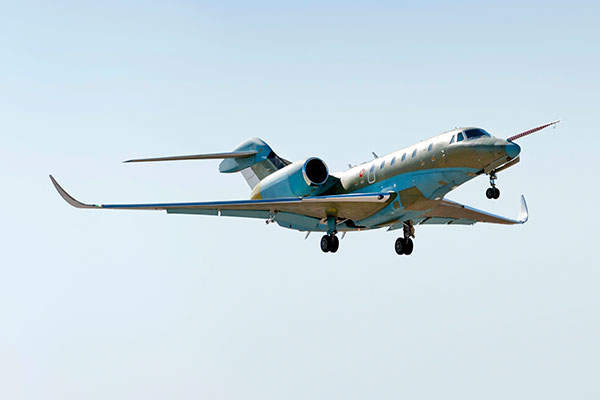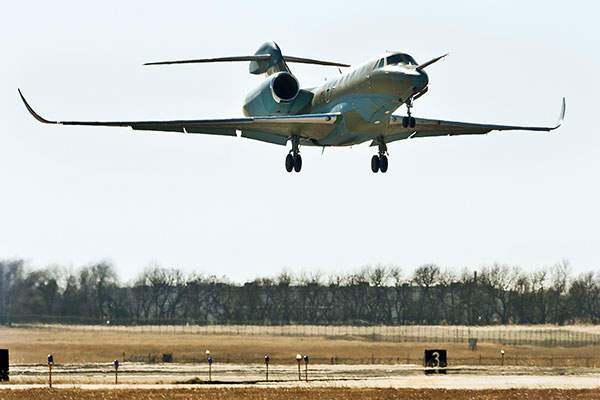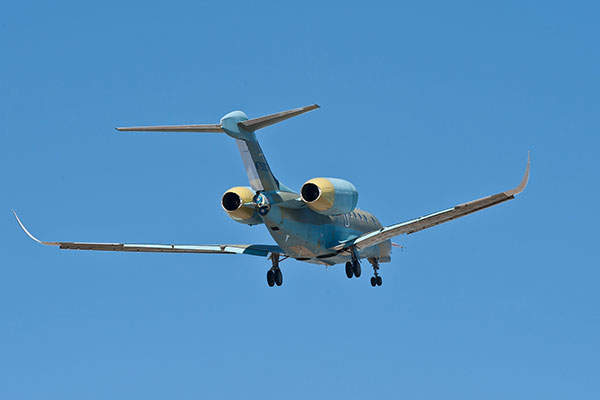
The Cessna Citation X+ business jet is an advanced variant of the Citation X (Model 750) aircraft.

The Cessna Citation X+ business jet performed its maiden flight in January 2012.

A rear view of the Cessna Citation X+ business jet.
Citation X+ is a mid-size business jet developed by Cessna Aircraft, a Textron company. It is an upgraded version of the Citation X (Model 750) aircraft. The aircraft is designed to transport up to 12 passengers and two pilots.
The Citation TEN development project was announced at the National Business Aviation Association (NBAA) 2010 convention. The maiden flight of the first prototype was successfully completed in January 2012. The US Federal Aviation Administration (FAA) type certification was awarded in June 2014. Deliveries began in the same month of that year.
Citation X+ became the fastest civil aircraft in the world when it attained a maximum speed of Mach 0.935 (712mph) during a flight test in August 2012.
Cessna Citation X+ design
Citation X+ is designed to outperform its predecessor in terms of speed and range. It incorporates a sweptback wing design. The circular fuselage section is attached with a highly swept wing and tail assembly integrating a highly swept T-tail with a moving horizontal stabiliser and elevators.
The nose section is equipped with a contoured radome and electrically heated windshields. The wing integrates fuselage attachment points, while the fuel is stored in two wing tanks and one centre tank.
The aircraft has a length of 22.4m, width of 21.1m and height of 5.86m. Its maximum take-off weight is 16,601kg.
Citation X+ flight deck
The flight deck of Citation X+ accommodates two pilots. It is equipped with Garmin G5000 avionics suite integrated with two primary flight displays (PFDs) and a multi-function display (MFD) for monitoring the engine, flight control, hydraulic and electrical systems. The crew can control the system characteristics using four-colour touchscreen control panels.
Pilot and co-pilot stations are equipped with engine power levers, speed brake control lever and flaps/slats control. Other equipment and systems include automatic flight control system (AFCS), dual flight management systems (FMS), inertial navigation system (INS), global positioning system (GPS), VHF communication and navigation radios, traffic collision avoidance system (TCAS II), terrain awareness warning system (TAWS) and weather radar.
The synthetic vision technology (SVT) on board the flight deck displays three-dimensional views of runways, terrains and obstacles on the primary flight displays.
Also included in the SVT is a flight path indicator, which provides increased situational awareness during approaches.
Cabin features of Citation X+
The cabin of Citation X+ has a length of 7.67m, continuous width of 1.68m and height of 1.73m. Divided from the flight deck by sliding cockpit doors, the cabin extends until the mid-pressure bulkhead. In addition, the extended cabin offers extra passenger legroom in the forward club seating area.
The cabin is fitted with 13 electrically tinted oval-shaped windows. Each passenger is provided with a dropdown oxygen mask, individual air outlets and LED task light. The cabin also offers stowage spaces and closets to accommodate briefcases, hand baggage and laptop bags. The passenger seats are provided with a seat belt and shoulder harness belt.
In the aft lavatory, there is a toilet, vanity sink and storage compartments. The lighting scheme of the cabin consists of general LED lighting, dropped aisle LED lighting, and entry and emergency exit lights. Customers can select the interior styling according to their own needs.
The Clairity cabin technology solution on board the Citation X+ offers a touchscreen-based digital entertainment system for passengers. Passengers can connect their personal devices to the panel fitted on either side of the seat. The on-board galley offers food and beverage services.
Cargo compartment
A 2.04m³ (72ftm³) pressurised and heated baggage section is located in the aft fuselage. The compartment is accessible through a door on the left-hand side of the fuselage. The aircraft also offers an additional 0.28m³ (9.8ft³) utility cargo area for the storage of cargo such as skis.
Engines
Two Rolls-Royce AE3007C2 turbofan engines mounted on the rear fuselage power the Citation X+. Each engine rated at 7,034lb is equipped with dual-channel full authority digital electronic controls (FADEC). The FADEC system is fully compatible with the auto-throttle (A/T) system. In addition, the engine assembly is accessed through six large access panels and multiple borescope ports.
The auxiliary power unit (APU) in the tailcone stinger ensures engine start. The maximum certified in-flight usage of the APU is 31,000ft. The aircraft also integrates hydraulically operated, target-type thrust reversers.
Landing gear
The main landing gear has a trailing link design using dual wheels, tires and powered anti-skid carbon brakes. The nose gear is a conventional strut design with dual wheels and tires. Nose gear steering is provided by a hydraulic power steering system.
Performance
Capable of flying at a maximum altitude of 51,000ft, the Citation X+ can fly at a maximum cruise speed of the aircraft is 977km/h. Its maximum range is 6,008km.
Related content
Cessna Citation X and Columbus
Cessna says that the Citation X (also known as the model 750) is currently the fastest civilian aircraft, with an ability to cruise just under the sound barrier at Mach 0.92.
Cessna Citation Latitude Business Jet
Citation Latitude is a new light business jet designed by Cessna. It is a low wing aircraft with retractable tricycle landing gear and cruciform tail.











